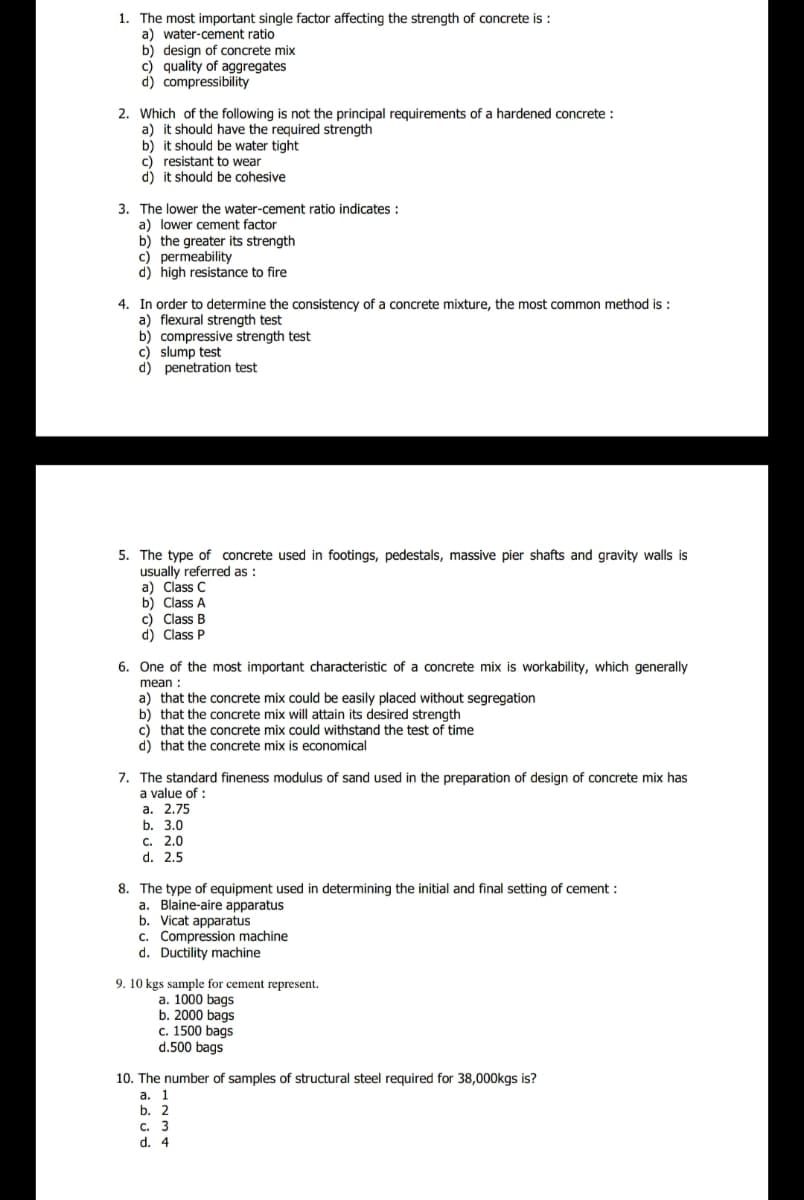1. The most important single factor affecting the strength of concrete is : a) water-cement ratio b) design of concrete mix c) quality of aggregates d) compressibility 2. Which of the following is not the principal requirements of a hardened concrete: a) it should have the required strength b) it should be water tight c) resistant to wear d) it should be cohesive 3. The lower the water-cement ratio indicates : a) lower cement factor b) the greater its strength c) permeability d) high resistance to fire
1. The most important single factor affecting the strength of concrete is : a) water-cement ratio b) design of concrete mix c) quality of aggregates d) compressibility 2. Which of the following is not the principal requirements of a hardened concrete: a) it should have the required strength b) it should be water tight c) resistant to wear d) it should be cohesive 3. The lower the water-cement ratio indicates : a) lower cement factor b) the greater its strength c) permeability d) high resistance to fire
Chapter2: Loads On Structures
Section: Chapter Questions
Problem 1P
Related questions
Question
Please answer the question correctly

Transcribed Image Text:1. The most important single factor affecting the strength of concrete is:
a) water-cement ratio
b) design of concrete mix
c) quality of aggregates
d) compressibility
2. Which of the following is not the principal requirements of a hardened concrete :
a) it should have the required strength
b) it should be water tight
c) resistant to wear
d) it should be cohesive
3. The lower the water-cement ratio indicates :
a) lower cement factor
b) the greater its strength
c) permeability
d) high resistance to fire
4. In order to determine the consistency of a concrete mixture, the most common method is :
a) flexural strength test
b) compressive strength test
c) slump test
d) penetration test
5. The type of concrete used in footings, pedestals, massive pier shafts and gravity walls is
usually referred as:
a) Class C
b) Class A
c) Class B
d) Class P
6. One of the most important characteristic of a concrete mix is workability, which generally
mean :
a) that the concrete mix could be easily placed without segregation
b) that the concrete mix will attain its desired strength
c) that the concrete mix could withstand the test of time
d) that the concrete mix is economical
7. The standard fineness modulus of sand used in the preparation of design of concrete mix has
a value of :
a. 2.75
b. 3.0
c. 2.0
d. 2.5
8. The type of equipment used in determining the initial and final setting of cement :
a. Blaine-aire apparatus
b. Vicat apparatus
c. Compression machine
d. Ductility machine
9. 10 kgs sample for cement represent.
a. 1000 bags
b. 2000 bags
c. 1500 bags
d.500 bags
10. The number of samples of structural steel required for 38,000kgs is?
a. 1
b. 2
c. 3
d. 4
Expert Solution
This question has been solved!
Explore an expertly crafted, step-by-step solution for a thorough understanding of key concepts.
Step by step
Solved in 3 steps with 3 images

Knowledge Booster
Learn more about
Need a deep-dive on the concept behind this application? Look no further. Learn more about this topic, civil-engineering and related others by exploring similar questions and additional content below.Recommended textbooks for you


Structural Analysis (10th Edition)
Civil Engineering
ISBN:
9780134610672
Author:
Russell C. Hibbeler
Publisher:
PEARSON

Principles of Foundation Engineering (MindTap Cou…
Civil Engineering
ISBN:
9781337705028
Author:
Braja M. Das, Nagaratnam Sivakugan
Publisher:
Cengage Learning


Structural Analysis (10th Edition)
Civil Engineering
ISBN:
9780134610672
Author:
Russell C. Hibbeler
Publisher:
PEARSON

Principles of Foundation Engineering (MindTap Cou…
Civil Engineering
ISBN:
9781337705028
Author:
Braja M. Das, Nagaratnam Sivakugan
Publisher:
Cengage Learning

Fundamentals of Structural Analysis
Civil Engineering
ISBN:
9780073398006
Author:
Kenneth M. Leet Emeritus, Chia-Ming Uang, Joel Lanning
Publisher:
McGraw-Hill Education


Traffic and Highway Engineering
Civil Engineering
ISBN:
9781305156241
Author:
Garber, Nicholas J.
Publisher:
Cengage Learning